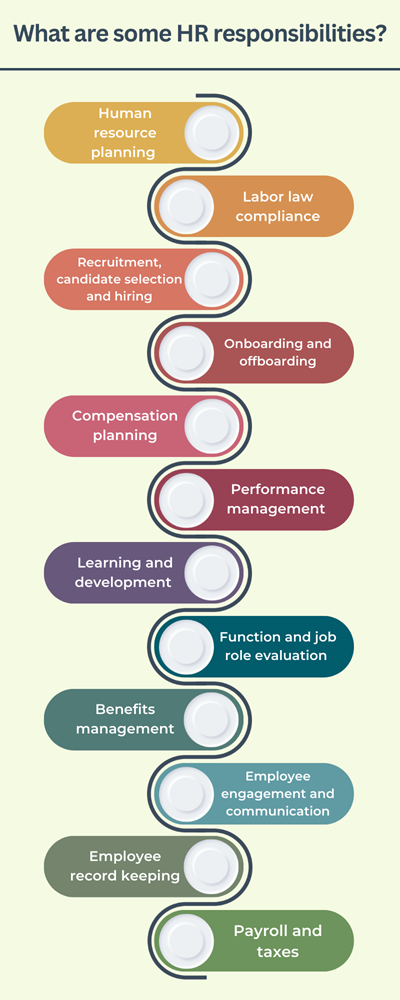Types of HR roles and how they contribute to a successful organization
Depending on the size and industry of an organization, you may hear different terms used in reference to human resources, including "HR," "employee relations," and "people management". However, these terms, while they may sound similar, aren’t interchangeable.
The same can be said for the different types of human resources jobs. However, whether you say employee relations, human resources, or people management, types of HR roles and associated functions are vital to overall organizational success.
Why? While there are various types of HR roles and jobs, the primary responsibility of an HR department is the management of your organization’s greatest resource: your people.
How well the professionals in different HR positions work together contributes to the functioning of the entire HR department thereby contributing to the overall success of an organization. Here is an overview of the various types of HR roles and positions, as well as the responsibilities each type of HR professional is tasked with.
What is HR?
HR is the short acronym for human resources. An HR department handles all administrative activities related to your current roster of employees and potential new hires. For instance, some of the typical responsibilities of an HR department include:
Recruiting or scouting
Hiring
Training new hires
Payroll and benefits administration
Depending on how you’ve structured your company, your HR department might also be tasked with:
Employee engagement
Creation and delivery of internal messaging and communications
Ongoing learning and skill development programs
The varied responsibilities of HR teams depend greatly on the company’s size and the types of human resources positions within the organization. Some businesses may have only a few people who manage HR tasks, whereas large corporations may have a large HR department. Other organizations may outsource HR tasks and responsibilities to a third-party organization.

HR responsibilities and specialties | Source: Author
5 different types of HR roles
Human resources isn’t a singular discipline, but rather a complex interplay of various roles, each contributing to the organization in a distinctive way.
1. Recruiting and staffing
Recruitment and staffing, although distinct, are integral aspects of the organization's workforce strategy. Recruitment is a proactive endeavor to discover potential candidates suitable for job roles, concluding in the selection process—a core aspect of staffing—where the most apt candidates are chosen.
Organizations can benefit from either internal or external recruiting teams to attract, engage, and onboard candidates. Staffing encompasses all the processes crucial to developing and retaining a solid workforce.
2. Employee relations
HR is the catalyst that identifies and mitigates potential workplace issues through internal employee engagement surveys, meetings, and a holistic understanding of the organizational landscape. By incorporating approaches that foster a healthy workplace culture, HR plays a pivotal role in addressing employee activity, burnout, and conflict resolution.
Organizations benefit from the establishment of communication standards, which promote transparency and encourage openness within the organizational hierarchy.
3. Learning and development (L&D)
Commonly abbreviated as L&D, learning and development is often considered an extension of the HR department. An L&D team is entrusted with the responsibility of providing training, skills development, and other professional opportunities, enabling employees to enhance their performance or transition to new roles within the organization.
While company budgets constrain many L&D teams, companies can benefit from robust training programs in career development, leadership development, skills training, compliance training, and continuing education courses.
4. Performance management
Performance management, while tailored to each organization, primarily involves evaluating employees against established objectives and expectations. Effective performance management can generate a sense of connection among employees toward the broader organizational goals, illuminating the impact of their contributions.
Businesses benefit from performance management types of HR responsibilities, such as clearly communicated expectations and fair performance evaluations, resulting in a positive workplace culture, clearer communication, and enhanced employee engagement—all of which are fundamental elements of improved productivity.
5. Company culture
Although not solely the responsibility of HR, the HR department is uniquely positioned to influence and cultivate a positive company culture. From recruiting to nurturing employer-employee relationships, HR plays a critical role in communicating the organizational ethos to potential and existing candidates and ensuring a symbiotic alignment between recruits and the organizational culture.
Through these endeavors, HR strives to create a vibrant work environment conducive to both personal and organizational growth.
How HR roles contribute to organizational success
HR is the cornerstone of an organization, fundamentally contributing to its success through strategic recruitment and talent management methods and initiatives. HR positively contributes to organizational success by identifying and attracting individuals whose skills, values, and ambitions resonate with an organization's goals.
Human resources implements training and development programs that promote growth and adaptability, which helps ensure the company remains competitive in a business landscape that’s always shifting. Plus, HR policies on employee relations, compensation, and benefits can bolster employee satisfaction, employee retention, productivity, and overall organizational culture.
How to choose the right HR roles for your company to focus on
Choosing the right human resources roles for your organization requires a profound understanding of your company's current and future needs.
Begin by evaluating your organization’s strategic objectives and identifying the gaps in your workforce that could hinder those goals. Focus on roles that drive growth, such as talent acquisition specialists who can build a strong team, or learning and development trainers who can help enhance employee skills and knowledge.
Prioritize roles that shape company culture and employee engagement, such as employee relations managers or benefits coordinators.
When you invest in HR roles that align with your business’s priorities, you help ensure a more efficient, satisfied, and high-performing workforce.
Position your team for success
Focus on the types of HR roles that make the most sense for your company and leverage the appropriate HR systems judiciously. This not only augments operational efficiency but also strategically boosts your chosen HR initiatives and prepares your business to navigate the multifaceted HR landscape with agility and foresight.
Check out these Capterra resources for further learning:

